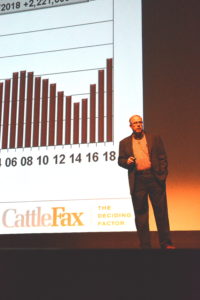Farm & Ranch
[AgriLife Today] Cattle producers learn how to deal with smaller profit margins

By: Blair Fannin
Texas A&M Beef Cattle Short Course attracts record attendance
Writer: Blair Fannin, 979-845-2259, [email protected]
COLLEGE STATION – After two years of historic high cattle prices, a record 1,900 producers attending the Texas A&M Beef Cattle Short Course in College Station learned more about the current decline in prices and maintaining profitability despite declining profit margins.
“We’ve had quite a run over the past two years with regards to high cattle prices,” said Dr. Jason Cleere, conference coordinator and Texas A&M AgriLife Extension Service beef cattle specialist, College Station. “Cattle prices fell considerably last fall and ranchers are concerned with where they will go in the future.”
Beef producers attending this week’s short course were all too familiar with the decline in prices.
“If prices would just stabilize, it would take some panic out of the market,” said Greg Goudeau, cattle producer and owner of Navasota Livestock Auction Co.
“We’ve seen quite a slide, 40 percent, which is quite challenging,” said Gerald Sullivan, who co-owns Santa Rosa Ranch in Navasota and Crockett with his daughter, Kelley Sullivan. “Not everything is bad, not everything is good. We’re also seeing an uptick in per capita consumption of beef. That’s directly related to the cost as far as I am concerned. I believe we are going to be looking at two or three years of this before we see a turnaround. I’m not sure where the bottom is at this point, but we’ve seen this before.”
Dr. Ted McCollum, AgriLife Extension beef cattle specialist, Amarillo, said during the general session, “It’s like a game of limbo right now. How low can you go? Price discovery in the fed cattle market has been an issue as well as volatility in the futures markets and relation to the cash markets.”
Duane Lenz, CattleFax market analyst, said it was the best of times when prices rallied to historic levels in 2015 and hundreds of dollars in profit margins were raved.

Duane Lenz, CattleFax market analyst, gives a cattle market outlook at the 62nd Texas A&M Beef Cattle Short Course. (Texas A&M AgriLife Extension Service photo by Blair Fannin)
“Looking back at historical returns, in 2015 it wasn’t good; it was really, really good,” he said.
But when prices started to break going into the fall and spiral downward, Lenz said feeder operators who paid high bids began holding on to cattle, feeding them longer, hoping for prices to come back up to a level of profitability. When those cattle went to slaughter, weights were significantly higher and lots of beef was on the market.
That also pressured prices downward, he said. As a result, that left a lot of beef that continues to be cycled through the chain, which has weighed heavily on prices. Commodities across the board, led by the energy sector, have seen sharp declines due to global economic concerns, which hasn’t helped spark strong rallies in cattle prices.
Looking forward, Lenz said consumption is forecasted upward and export demand for beef is also projected higher in the coming years. That’s good news, he said, as lower cattle prices have also trickled down to the retail meat case and major grocery chains have returned to featuring beef cuts in weekly sales flyers.
Though prices won’t reach historic levels seen in 2015, the floor price for a 550-pound steer is targeted at $155 per hundredweight, he said.
“Could we see $150 to $155 in the coming years? We probably could,” Lenz said.
But just two weeks ago, Lenz said Kansas fed-cattle prices reached as low as $115 per hundredweight.
“Now we’re getting in the mid-$120s,” he said. “There’s no reason we can’t be there as we finish out the year. But going into next spring, $105-$110 is a possibility.”

Brian Bledsoe, meteorologist, who is featured in Southern Livestock Standard, gives a weather outlook at the 62nd Texas A&M Beef Cattle Short Course. (Texas A&M AgriLife Extension Service photo by Blair Fannin)
By comparison, 2015 prices got as high as $275 per hundredweight for a 550-pound steer.
The beef short course is one of the largest beef-education workshops in the country. This year’s short course attracted participants from 24 states and eight countries, Cleere said. Many attended the two-and-a-half day event to receive comprehensive education from a variety of experts.
“Where else can you go in Texas and find 1,500 ranchers and vendors?” Goudeau said. “It’s not just the sessions, but an event to find out about what your friends and neighbors are doing with their operations. It’s a rancher’s family reunion. It’s a place to learn more about the hot topics in the industry.”
“There are a number of different sessions you can attend and really pinpoint what we are doing and you can do it all at one time in one place,” said Sullivan, who operates a seed-stock cattle operation. “You don’t get to see all the people at the same time. Plus the trade show, you pick up on tidbits of information that are valuable to your operation. For us, two things, we meet with our customers and potential customers and having all the experts in one place. It’s efficiency, getting to see everyone at the same time.”
This year’s short course was dedicated to the late Rick Hirsch, AgriLife Extension agent for Henderson County. Hirsch passed away unexpectedly in April. His family was recognized during the formal dedication by Cleere during the Aggie Prime Rib Dinner Monday evening.
The short course is coordinated by AgriLife Extension and the department of animal science at Texas A&M. The event showcases the latest research and educational programs offered by AgriLife Extension, Texas A&M AgriLife Research and the department of animal science at Texas A&M. The short course continues through Wednesday.
-30-
Find more stories, photos, videos and audio at http://today.agrilife.org
Farm & Ranch
Acorn Toxicity

By Barry Whitworth, DVM, MPH
With the prolonged drought, most pastures in Oklahoma end up in poor condition. With the lack of available forage, animals may go in search of alternative foods.
If oak trees are in the pastures, acorns may be a favorite meal for some livestock in the fall. This may result in oak poisoning.
Oak leaves, twigs, buds, and acorns may be toxic to some animals when consumed.
To read more, pick up a copy of the November edition of North Texas Farm & Ranch magazine, available digitally and in print. To subscribe by mail, call 940-872-5922.

Farm & Ranch
Silver Bluestems

By: Tony Dean
There are a handful of grasses on North Texas grazing lands ranchers need to know, not because they are highly desirable, but rather because they are not of much value. I call them “decom” plants, which is am acronym for “Don’t Ever Count On Me.” Silver bluestem is a “decom” grass.
Silver bluestem is a perennial which grows in all areas of Texas. It can survive in almost all soil types, and in full sun conditions or in semi shade. It grows up to three feet tall and is easily recognized with the presence of the white fuzzy seed head. Also, one of the identifying characteristics of Silver bluestem is a bend in the stems at each node, causing the plants to take on a rounded shape as they mature.
To read more, pick up a copy of the November edition of North Texas Farm & Ranch magazine, available digitally and in print. To subscribe by mail, call 940-872-5922.

Farm & Ranch
Meanwhile Back At The Ranch

By: Rayford Pullen
Fall is here which means winter is closing in on us and before we officially get into winter, we need to make sure our factories are either producing or will be producing in a few months.
We have been pregnancy testing our cows this fall and if they are not bred or nursing a calf, we are bidding them adios. With annual costs somewhere between $900.00 and $1,000.00 per cow, those cows not producing a live weaned calf are costing us quite a bit.
To read more, pick up a copy of the November edition of North Texas Farm & Ranch magazine, available digitally and in print. To subscribe by mail, call 940-872-5922.
-

 Country Lifestyles2 years ago
Country Lifestyles2 years agoScott & Stacey Schumacher: A Growth Mindset
-

 Country Lifestyles8 years ago
Country Lifestyles8 years agoStyle Your Profile – What your style cowboy hat says about you and new trends in 2017
-

 HOME8 years ago
HOME8 years agoGrazing North Texas – Wilman Lovegrass
-

 Equine1 year ago
Equine1 year agoThe Will to Win
-

 Country Lifestyles5 years ago
Country Lifestyles5 years agoAmber Crawford, Breakaway Roper
-

 Outdoor9 years ago
Outdoor9 years agoButtercup or Primrose?
-

 Country Lifestyles8 years ago
Country Lifestyles8 years agoJune 2016 Profile – The man behind the mic: Bob Tallman
-

 Country Lifestyles8 years ago
Country Lifestyles8 years agoDecember 2016 Profile, Rusty Riddle – The Riddle Way




